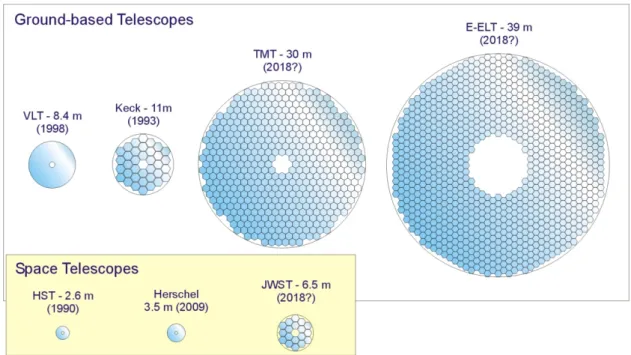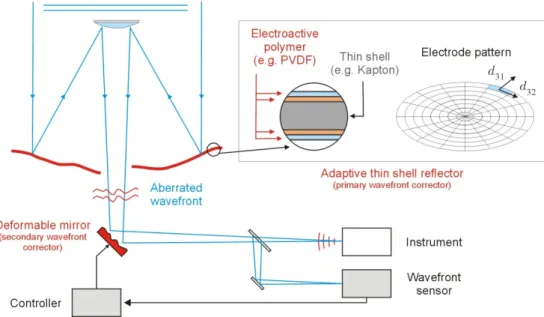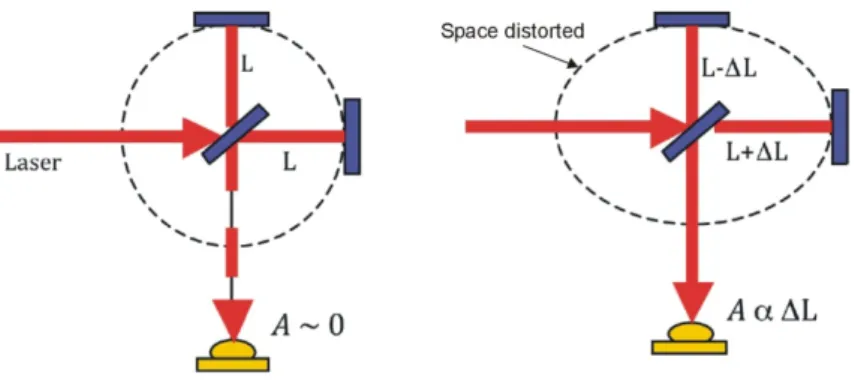CHALLENGES IN PRECISION AND VIBRATION CONTROL FOR PHYSICS EXPERIMENTS
A. Preumont, R. Bastaits, I. Surdej & Ch. Collette
Active Structures Laboratory, Université Libre de Bruxelles, Belgium
Physicists, unlike engineers, are notorious for knowing no limits, except, maybe, the funding… This optimistic and ambitious attitude has led to a number of successful projects and engineering wonders, like the Hubble Space Telescope (NASA, 1990), the Keck telescope (first segmented telescope, 1993) or the LHC (CERN, 2009), to name only a few. The present paper examines some of the on-going development projects for new facilities with even more impressive capabilities, from the viewpoint of precision and vibration control requirements.
1) Earth-based astronomy: There has been a change of paradigm in the telescope technology,
with the advent of segmented mirrors (Keck, 1993), which, seemingly, makes the very large telescopes scalable to infinity, especially with the success of Adaptive Optics which removes the blur due to the atmospheric turbulence: “the only clearly identified show stopper seems to be the funding”(!) [Gilmozzi]. Several projects are due to see first light during this decade: TMT (primary mirror M1 of 30 m) and E-ELT (M1 diameter initially foreseen of 42 m, and recently reduced to 39 m), Figure 1. Note that the wave front error allowed for good image quality is only related to the wavelength observed (λ/14), making the ratio ε=precision/size significantly smaller than any existing project. The size of these structures makes them increasingly sensitive to external disturbances such as the change of the gravity vector due to the earth rotation and wind; this requires control systems with larger bandwidth, conflicting with decreasing natural frequencies and very light damping. A scale effect analysis [Preumont] shows that the behavior of these complex opto-mechatronics systems is threatened by control-structure interaction, which was so far insignificant, or at least manageable [Aubrun].
The use of the VLT telescopes as an interferometer has long been prevented by the excessive vibration level of the system.
2) Space telescopes: Space telescopes are necessary to observe the wavelengths which are not
accessible from earth (they have become less necessary in the visible, because of the advent of Adaptive Optics). The James Webb telescope (JWST) will be the first telescope to be
deployed in space (2018?); it will operate in the visible and near infrared at the Lagrange
point L2. Its primary mirror will have a diameter of 6.5 m and will consist of 18 segments actively controlled (Figure 1). Even with this moderate size, the project turned out to be extremely expensive, the current budget of 9 b$ being five times the initial one, so that it has been described as "the telescope that ate astronomy".
On a longer time scale, there is a need for large space reflectors with a diameter of 10 m and more, but this can only be achieved by so-called gossamer telescope structures and membrane optics. The surface figure accuracy will require several active control layers, by means of active material integrated in the primary reflector, and a secondary wave front corrector working in a manner similar to Adaptive Optics (Figure 2). Structures will be replaced by information [Bekey].
Figure 2: Conceptual design of a space telescope consisting of an adaptive thin shell reflector (which deploys under its own strain energy) and a AO deformable mirror used as secondary wavefront corrector.
3) High Energy Particle physics: Since the early days of particle physics, the energy and size of
the colliders have been multiplied by 5 orders of magnitude. Capitalizing on the success of the LHC (Large Hydron Collider), which collides proton’s size particles, the next generation of colliders is being developed at CERN and other research institutes. One of the options considered, called CLIC (Compact Linear Collider) consists of a straight line of 48 km colliding two beams of electron size particles; in order to achieve an adequate luminosity, the size of the beam in the final focus section is of the order of 1 nm, requiring a sub-nanometric precision in the beam positioning (Figure 3). The system is segmented into short modules
which accelerate and steer the beam of particles; several control layers are foreseen to isolate the system from the environment, and align the various segments.
Figure 3: Typical cross sections of the colliding beams in the future linear collider CLIC.
4) Gravitational wave detection: According to Einstein's general theory of relativity,
astronomical events like coalescence of black holes and supernovas generate gravitational waves which distort the space. Over the years, various instruments have been developed to detect them, but so far none was successful, because they did not have (by far) the adequate sensitivity. It is currently estimated that the instrument should be able to detect deformations of the order of 10-21, i.e. a relative displacement of ࢤL=10-18m of two points located L=1km apart, which probably appears out of scope to most precision engineers (the ultimate limit in manufacturing, the atomic lattice distance, is of the order of 10-10m). The most recent earth-based projects, called VIRGO and LIGO, use multi-kilometer interferometers (Figure 4); the sensitivity of the detector is essentially proportional to the distance travelled by the light in the instrument; the principal disturbance is the natural seismic noise which must be reduced by ten orders of magnitude at 10 Hz (assuming a decay rate of 40 dB per decade, this calls for an isolation corner frequency of 10-4 Hz).
Figure 4 Michelson interferometer for gravitational wave detection (VIRGO, LIGO).
The joint ESA/NASA mission called LISA (Laser Interferometer Space Antenna) will attempt to detect gravitational waves by monitoring the position of three spacecrafts located at the apices of an equilateral triangle, distant of 5 million km.
Conclusion:
The future of experimental physics will demand larger and more precise experimental facilities. According to the roadmap, the increase in size of the instruments could even accelerate during the 21st century, at least if the funding is available... Larger size and more precision will inevitably lead to new challenges for the engineering community, in the field of
systems and control, vibration alleviation, control-structure interaction and precision metrology. We should prepare for it.
On the other hand, there has been constant progresses in extreme precision engineering, which have been translated in the continuous application of Moore's law from the 70's until now. Many control systems initially developed for experimental physics have been transferred to medicine and other daily life applications.
References:
Aubrun, J.N., et al. Performance Analysis of the Segment Alignment Control System for the Ten-Meter Telescope, Automatica, Vol.24, No 4, 437-453, 1988.
Bekey, I. Advanced Space System Concepts and Technologies: 2010-2030+, AIAA (2003). Gilmozzi, R. Science and technology drivers for future giant telescopes, in Ground-based
Telescopes. Proceedings of the SPIE, 5489 (2004) 1-10.
Preumont, A. et al. Scale Effects in Active Optics of Large Segmented Mirrors, Mechatronics,
19, 1286-1293, 2009.
Shore, P. et al. Precision engineering for astronomy and gravity science, CIRP Annals,


